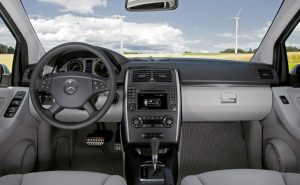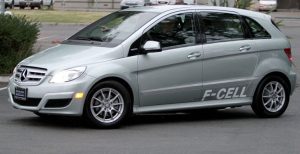Right in time for the Los Angeles Auto Show, Mercedes-Benz is presenting the new B-Class F-CELL, the first series production fuel-cell powered electric vehicle available in the U.S. Selected customers will take delivery of the first lease vehicles before the end of 2010. By 2012, a total of 200 of these environmentally friendly cars will be on the roads in California and Europe.
“California, with its progressive environmental legislation, is the ideal region for everyday operation of a true zero-emissions vehicle,” says Dr. Thomas Weber, member of the Daimler AG Board of Management responsible for Group Research and Head of Development for Mercedes-Benz Cars. With the model year 2011 B-Class F-CELL, Mercedes-Benz is the first manufacturer to offer a fuel-cell powered Zero-Emissions Vehicle that has been certified by the EPA (Environmental Protection Agency) and CARB (California Air Resources Board). Dr. Thomas Weber: “After more than 362,500 miles covered by the A-Class F-CELL test fleet, we are continuing to build on our experience with the latest generation of electric cars with fuel cell drive. With the BClass F-CELL cars in California, we will have more than doubled the size of the existing fleet in customer hands – marking a further milestone en route to bringing this technology to market by 2015.”
Latest generation of fuel-cell powered vehicles
With an operating range of around 240 miles (Euro driving cycle, 190 miles estimated EPA) and short refueling times, the Mercedes-Benz B-Class F-CELL combines local zero-emissions mobility with long-distance comfort and compelling performance figures. The technical basis for the drive system of the B-Class F-CELL is the optimized, new-generation fuel cell system. This is some 40 percent smaller than the system in the A-Class F-CELL – which has been undergoing practical trials in the U.S. since 2004 – but generates 30 percent more power, while consuming 30 percent less fuel. The cold-start capability of the B-Class F-CELL is down to -13 degrees Fahrenheit.
The 136 hp electric motor in the B-Class F-CELL develops a powerful torque of 214 lbft from standstill and delivers driving pleasure and dynamics on par with a two-liter gasoline engine.
Everyday use by customers
The B-Class F-CELL is extremely well suited to everyday driving. During the NHA Hydrogen Conference & Expo in May 2010, California Governor Arnold Schwarzenegger enthused, “I would love one of these fuel-cell powered Mercedes cars!” On the basis of market research data, Mercedes-Benz has chosen a representative customer group consisting of fleet operators, public institutions, public figures and private customers. The primary aim is to gain further experience in day-to-day operation, which can then be incorporated into subsequent models. A typical full-service monthly lease rate will be $849 excl. tax over a term of 24 months and includes the cost of hydrogen fuel.
Fuel cell safely integrated into the sandwich floor
At the heart of the B-Class F-CELL is the new-generation electric drive system powered by fuel cell, which is compact, powerful, safe and fully suitable for everyday use. The fuel cell generates the electric drive power directly on-board the vehicle from the chemical reaction of oxygen and hydrogen, which produces absolutely no harmful emissions – only pure water. The key drive components are located in the sandwich floor, where they are well-protected. This space-saving arrangement also leaves the vehicle interior and trunk fully usable.
Mercedes-Benz is the first manufacturer to produce a fuel-cell based electric drive system in a series-production compact car. Vehicle safety is at the very high levels expected of a Mercedes and is further enhanced by the location of the fuel tanks within the sandwich floor. The comprehensive safety concept devised for the B-Class F-CELL takes into account the specific characteristics of the innovative drive system. Mercedes-Benz has extensive experience in fuel-cell electric drive and high-voltage battery technology with vehicles such as the A-Class F-CELL and S400 HYBRID. This expertise, gained over many years, flowed into refining the concept. In other words, the high level of safety means that Mercedes-Benz fuel cell vehicles can use underground parking lots, multi-story parking garages or tunnels with no restrictions whatsoever. The vehicle design also makes for particularly safe and agile handling characteristics.
Operating range of around 240 miles* – fuel stations within range
The hydrogen used to run the fuel cell is stored in three tanks at a pressure of 10,150 psi. Each tank holds just under 8.8 lbs of the gaseous fuel. The tanks are hermetically sealed, preventing the escape of hydrogen into the atmosphere, even if the vehicle is left to stand for long periods. Thanks to this high-pressure fuel storage, the B-Class F-CELL can cover a distance of up to 240 miles (*Euro driving cycle, 190 miles estimated EPA) on a full tank, more than twice the range of the 2004 A-Class F-CELL. Once the tanks are empty, they can be filled simply and quickly in less than 3 minutes, thanks to a standardized refueling system.
Targeted fuel cell initiatives
In order to further the commercialization of hydrogen-powered vehicles, Mercedes- Benz is involved in the California Fuel Cell Partnership (CaFCP), an association of automobile manufacturers, energy suppliers, government agencies and technology companies, as well as in the newly formed Fuel Cell and Hydrogen Energy Association (FCHEA).
While the CaFCP is currently pursuing the transition from a demonstration project to early commercialization of fuel-cell drive systems at all levels, the State of California has already made $27 million available toward the development of a hydrogen infrastructure, with an additional $14 million anticipated in 2011.
There are currently five public hydrogen filling stations in the greater Los Angeles area, with four more due to open by the end of 2010. One is also planned for the San Francisco Bay area.
Key facts about the Mercedes-Benz B-Class F-CELL
- All electric-drive vehicle with an operating range of 240 miles (Euro driving cycle / 190 miles estimated EPA)
- A chemical reaction between oxygen and hydrogen produces electric power, which is fed into an electric motor
- Water is the only by-product
- The liquid-cooled lithium-ion battery is the energy storage medium and has a capacity of more than 1.4 kWh
The vehicle has front-wheel drive - Designed as a compact family car with full day-to-day practicality



